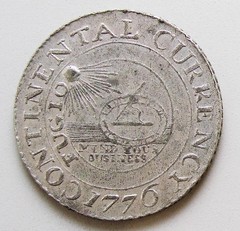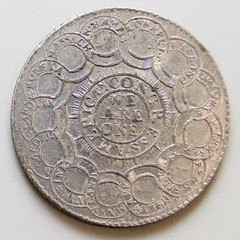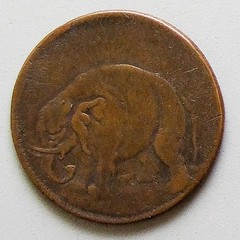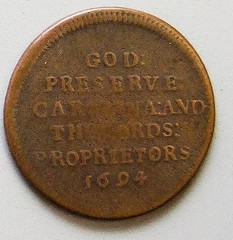
PREV ARTICLE
NEXT ARTICLE
FULL ISSUE
PREV FULL ISSUE
A VISIT TO YALE’S COIN AND MEDAL COLLECTION
Joe Esposito submitted this item about his recent visit to the Coin and Medal Collection at the Yale Art Gallery. Thanks! -Editor
A Visit to Yale’s Coin and Medal Collection
Each June for the past three years I have participated in the Yale Writers’ Conference in New Haven, Connecticut. This year I added a visit to the Yale Art Gallery, specifically the Coins and Medal Collection, and it turned out to be a memorable numismatic experience. This collection, mostly seen by appointment, includes more than 120,000 coins, from colonial American to world specimens; thousands of paper notes; and a wide range of medals, tokens and store cards. One third of the coins are ancients. This is the largest coin collection at any American university. There also are coins scattered throughout the museum as part of thematic displays, such as one on American silver, where a Massachusetts willow tree shilling accompanies other objects. Outside the numismatic rooms are display cases of coins and medals which highlight nature, architecture, women, Antoninus Pius and the House of Tudor. At the entrance to the collection is a display case with twelve medals and coins representing some of the most important works of Bela Lyon Pratt (1867-1917), perhaps most noted for his design of the quarter and half eagle coins, examples of which are exhibited. Among the medals shown here are those for the Tavern Club of Boston, the New Theatre in New York and a large Yale Bicentennial Medal of 1901, one of a dozen of these in silver or bronze in this collection. Pratt was a Yale graduate—as well as a protégé of Augustus Saint-Gaudens--and the coin center is identified as the Bela Lyon Pratt Study Room for Coins and Medals. A cast bronze plaque of Pratt by Richard Henry Recchia, a student of his, is outside the door. The study room is actually two rooms, one which contains large vaults with trays of coins and space for viewing them and the other is a library and seminar room. Periodically, art, classics or economics classes meet here. I e-mailed and made an appointment with Jane Miller, a senior museum assistant who works on the collection. She and John Stuart Gordon, an associate curator, were generous with their time, discussing the history of the collection and the range of the holdings; providing a select tour of the museum; and, most fascinating, allowing me to study a number of coins. My interest was primarily in colonial coins, and my hosts assembled a sumptuous array in two large trays taken from the vaults. Each coin was housed in a handmade origami-type holder and, after cleaning my hands with a hand sanitizer, I was allowed to handle whichever ones I chose. Now this is the incredible part: I was able to hold such treasures as a New England shilling; four of the five Libertas Americana medals—silver, gilt, copper and bronze cast (another silver is on display); and three Continental dollars—the Newman 1-C, 2-C and 3-D (here’s one example: http://artgallery.yale.edu/collections/objects/170936. There also was a 1793 bronze cent.  
The colonial currency selection is impressive. I examined an uncut, double sheet with twenty-four, four-pence 1776 Pennsylvania notes from Hall and Sellers, which was spectacular. There also were two uncut sheets of Rhode Island notes. This was only a sampling. Among other highlights of the American collection is an extensive amount of Confederate currency, and colonial Connecticut coppers and medals bequeathed by C. Wyllys Betts, another Yale alumnus. Of course, Betts’s book on colonial medals, published posthumously in 1894, is a classic. The world coin collection is also strong. It includes more than 3,000 pieces of German Notgeld money of the 1920s, ten trays of German medals, and various coins and medals from Europe and Asia. There also is a large holding in Chinese paper money. The Yale Art Gallery has what is described as “the finest collection of early American silver in the world.” As such, coins form part of the gallery display of silver. Among these are the Montreal Peace Medal of 1760 and the previously mentioned willow tree shilling. A Carolina elephant token, a bronze, also is on display: http://artgallery.yale.edu/collections/objects/165110  
The collection, which moved from the nearby Sterling Memorial Library in 2001, has an interesting history. One bit of lore is that students long ago were able to check out coins from the library and study them in their rooms; they were on the honor system. But on a less honorable side, the collection’s Brasher Doubloon was stolen by thieves in 1965. It was later recovered and auctioned by Stack’s for $650,000 in 1981. This is the Parmelee Specimen, one of seven Brasher Doubloons, and was last sold for $2.4 million in 2005. Visits can be made to this fascinating, but perhaps lesser known numismatic treasure trove from Tuesday through Friday during normal business hours. The website provides additional information as well as excellent photos and descriptions of most of the coins in the collection. For more information, see:
Wayne Homren, Editor The Numismatic Bibliomania Society is a non-profit organization promoting numismatic literature. See our web site at coinbooks.org. To submit items for publication in The E-Sylum, write to the Editor at this address: whomren@gmail.com To subscribe go to: https://my.binhost.com/lists/listinfo/esylum All Rights Reserved. NBS Home Page Contact the NBS webmaster 
|